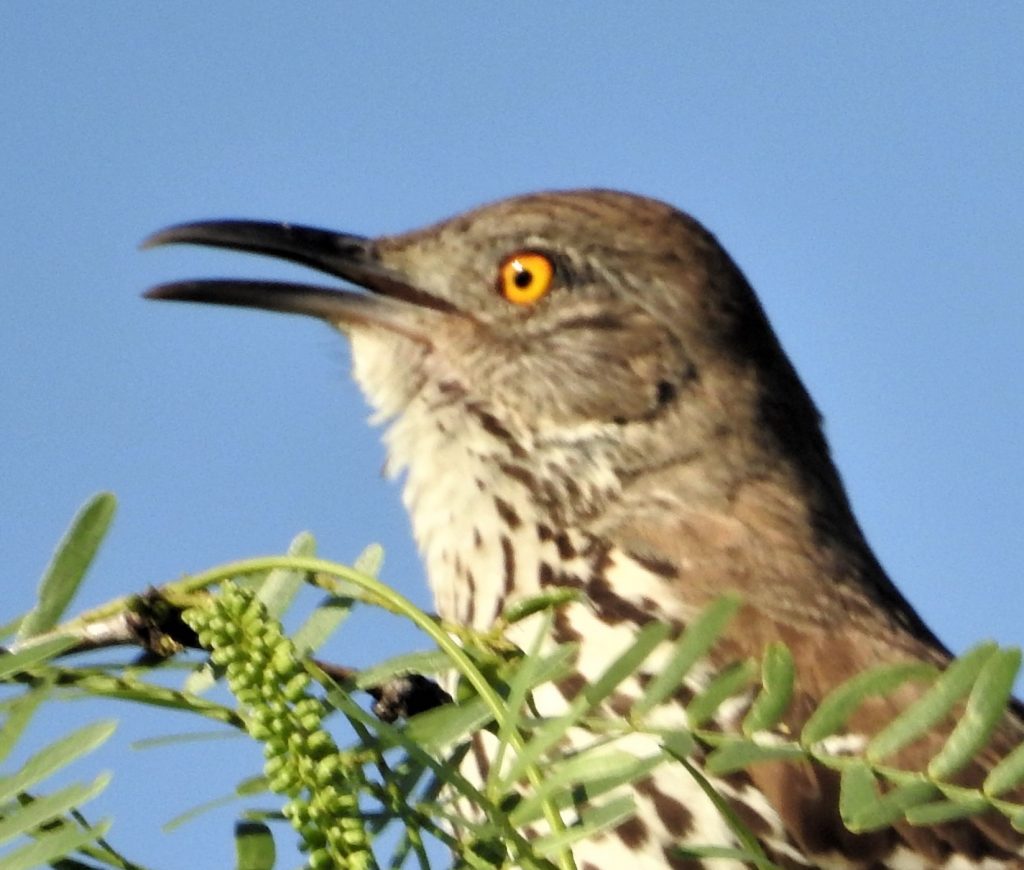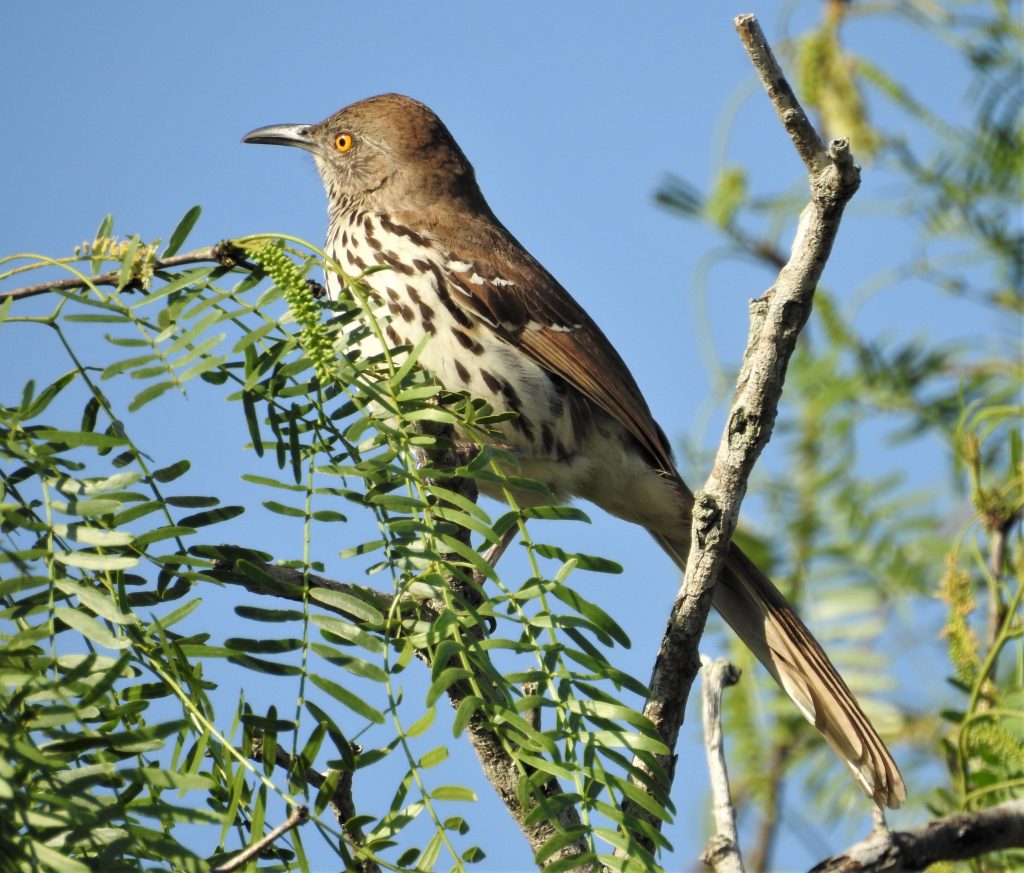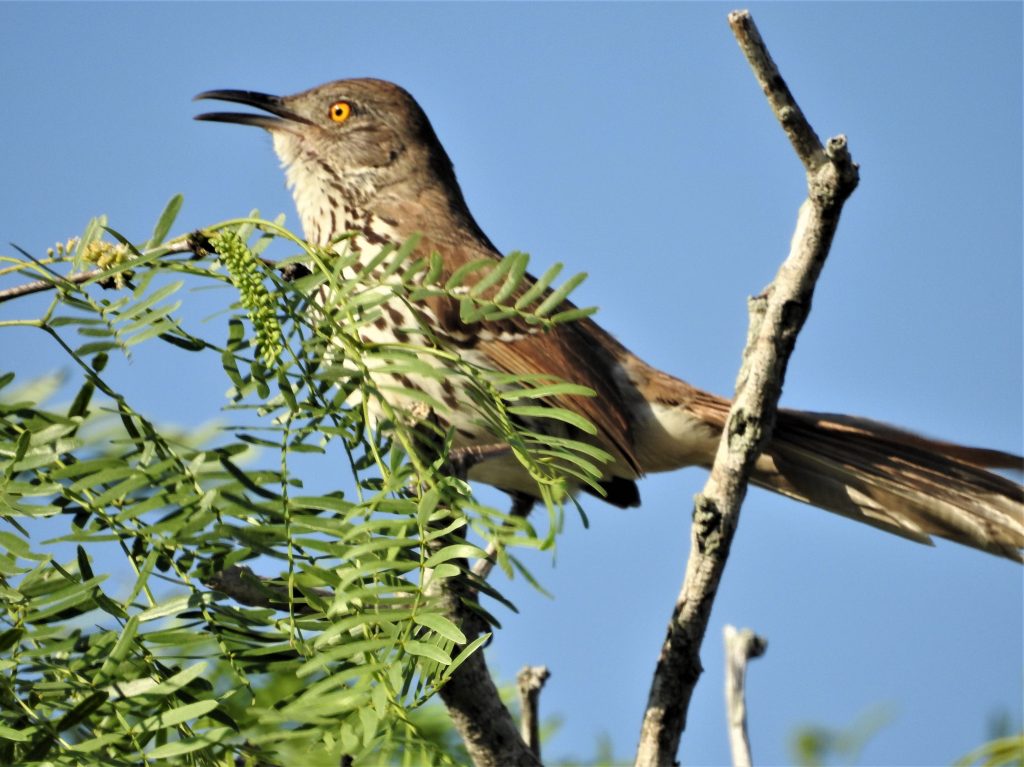Lush, intricate melodies tumbled from a willow tree near the river at Sabal Palm Sanctuary one unusually quiet midday afternoon. But, searching treetops for the presumed songster, the illustrious northern mockingbird, I found none. Then, to my surprise, I realized this sweetness poured from a brownish, orange-eyed bird with a black-streaked underside perched on a lofty twig. I didn’t know what it was.

A bit of conversation and research enlightened me, as I’d thought mockingbirds held a monopoly on such splendid arias. It was a cousin, a long-billed thrasher (Toxostoma longirostre) which—along with the mockingbird, gray catbird and various thrashers, including its fellow resident, the curve-billed—is a mimid, a member of the family Mimidae. By all reputes, this male’s hearty, complex springtime melody rivals that of the famed mockingbird, though it, unlike its cousin, is not known to mimic songs and noises.
The long-billed thrasher’s genus name, Toxostoma, comes from Ancient Greek “toxon,” which means to “bow” or “arch”, and “stoma”, for mouth—which might describe how its ilk thrash, or rummage, through leaf litter, flinging aside twigs and rocks, to probe the soil for insects, spiders, snails and other invertebrates.

The long-billed thrasher pounds particularly hard-packed dirt straight downward with its bill, bracing its tail against the ground. It also relishes berries, especially those from granjeno, brasil, prickly pear, sugar hackberry, anacua and Texas persimmon.
The gray catbird and brown thrasher—the long-billed thrasher’s closest relative—appear locally during the fall or spring migration or wintertime. While the long-billed resides in dense scrub thickets and woodlands, the resident curve-billed, a grayish brown bird, forages in more open lands and neighborhoods.
A non-migratory native of South Texas and northeastern Mexico, from about San Antonio downward, the long-billed thrasher apparently dwells in well-defined, compact territories, as evidenced by sightings of banded birds.
Long-billed thrashers, who raise two yearly broods, begin their beautiful 15-to-20-minute mating songs as early as February in the Valley and continue through June, producing tunes similar to those of the more renowned brown-billed thrasher, but with, it appears, fewer repeated phrases. Some birders claim its melody surpasses the mockingbird’s in sweetness, but not in volume.
Apparently monogamous, both parents construct a cup nest of thorny twigs lined with Spanish moss, rootlets and bark, placing them deep within the dense, well-shaded foliage of trees or shrubs. Both fiercely defend nests, displacing, if necessary, nearby mockingbirds or roadrunners. Thrashers emit fervent calls of distress and attack humans who investigate their nests.
Both parents incubate the three or four brown-speckled, oval eggs, from which emerge, in about two weeks, pinkish-skinned, sparsely downed chicks. Both feed nestlings, trimming any challenging or hazardous food— detaching spider legs and grasshopper heads and wings. Chicks eat some fruit in about a week.
Bronzed cowbirds will lay eggs in thrashers’ nests, especially those from their second brood—which coincides more closely with cowbirds’ nesting seasons. Sometimes a long-billed thrasher will reject cowbird eggs, but other times, unwitting birds raise little cowbirds, at the expense of their own offspring.
All wild birds, but particularly the young, struggle to survive. One study showed that a quarter of long-billed thrasher eggs and half of hatched nestlings were lost to predation, most likely by snakes, skunks, bobcat, coyotes, roadrunners and Harris’s hawks.

The long-billed thrasher, which employs a short, jerky flight, also walks, runs and presses its way through bushes, seeking berries. A preening thrasher wets itself by wiping its feathers with dew and rubbing its sides on damp leaves, then ruffling and fluffing them.
The thrasher will displace winter visitors and others foraging in its territory. It defends itself against the brown thrasher, but, interestingly, not its cohabitant, the curve-billed.
While abundant, long-billed thrashers have faced a slight decline in Texas over the past few decades, due, likely, to the clearage and fragmentation of valuable scrub lands. Some have moved to ranchlands north of the Valley, but do not seem to breed there as productively. Since 95% of South Texas brushlands have been cleared, it is essential that we protect and enhance our local wildlife sanctuaries.